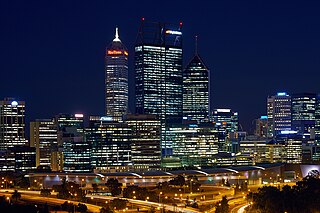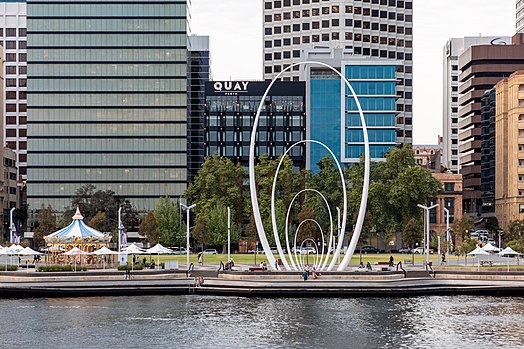
Shaivism is one of the major Hindu traditions, which worships Shiva as the Supreme Being. One of the largest Hindu denominations, it incorporates many sub-traditions ranging from devotional dualistic theism such as Shaiva Siddhanta to yoga-orientated monistic non-theism such as Kashmiri Shaivism. It considers both the Vedas and the Agama texts as important sources of theology. According to a 2010 estimate by Johnson and Grim, Shaivism is the second-largest Hindu sect, constituting about 253 million or 26.6% of Hindus.

A sculpture garden or sculpture park is an outdoor garden or park which includes the presentation of sculpture, usually several permanently sited works in durable materials in landscaped surroundings.

Swami Lakshman Joo, born Lakshman Raina and also called Lal Sahib by his followers, was a mystic and scholar of Kashmir Shaivism.

The Kashmir Shaivism tradition, also called Trika Shaivism, is a non-dualist branch of Shaiva-Shakta Tantra Hinduism that originated in Kashmir after 850 CE. In its place of origin in Kashmir, this tradition is commonly referred to as "Kashmiri Shaivism." It later spread beyond Kashmir, with its great scholar Abhinavagupta calling it "Trika". It particularly flourished in the states of Odisha and Maharashtra. Defining features of the Trika tradition are its idealistic and monistic Pratyabhijna ("Recognition") philosophical system, propounded by Utpaladeva and Abhinavagupta, and the centrality of the three goddesses Parā, Parāparā, and Aparā.
The Swan Bells are a set of 18 bells hanging in a specially built 82.5 metre copper and glass campanile in Perth, Western Australia. The tower is commonly known as The Bell Tower or the Swan Bell Tower.

The Museum of Contemporary Art Australia (MCA), formerly the Museum of Contemporary Art, Sydney, is located on George Street in The Rocks neighbourhood of Sydney. The museum is housed in the Stripped Classical/Art Deco-styled former Maritime Services Board (MSB) building on the western side of Circular Quay. A modern wing was added in 2012.

Highgate is an inner metro suburb of Perth, Western Australia, located within the City of Vincent and north of the central business district of Perth. Highgate was named for the village of Highgate, Hawkhurst in Kent, England. Highgate is the smallest suburb in the Perth metropolitan region, with an area of just 0.4 km2 (0.2 sq mi).

Elizabeth Quay railway station, also known as Esplanade station prior to 2016, is an underground railway station on the southern side of the Perth central business district in Western Australia.

Island Bridge, formerly Sarah or Sarah's Bridge, is a road bridge spanning the River Liffey, in Dublin, Ireland which joins the South Circular Road to Conyngham Road at the Phoenix Park.

St George's Cathedral is the principal Anglican church in the city of Perth, Western Australia, and the mother-church of the Anglican Diocese of Perth. It is located on St Georges Terrace in the centre of the city.
The Agamas are a collection of several Tantric literature and scriptures of Hindu schools. The term literally means tradition or "that which has come down", and the Agama texts describe cosmology, epistemology, philosophical doctrines, precepts on meditation and practices, four kinds of yoga, mantras, temple construction, deity worship and ways to attain sixfold desires. These canonical texts are in Tamil and Sanskrit.

Diana al-Hadid is a Syrian-born American contemporary artist who creates sculptures, installations, and drawings using various media. She lives and works in Brooklyn, New York. She is represented by Kasmin Gallery.

Perth is a suburb in the Perth metropolitan region, Western Australia that includes both the central business district of the city, and a suburban area spreading north to the northern side of Hyde Park. It does not include the separate suburbs of Northbridge or Highgate. Perth is split between the City of Perth and the City of Vincent local authorities, and was named after the city of the same name in Scotland.

The Florence Hummerston Kiosk is a building located at Elizabeth Quay in Perth, Western Australia. The kiosk was originally located on the Perth Esplanade, until being relocated to an islet at Elizabeth Quay. Originally constructed in 1928 as a tearoom, the kiosk was also known as the Esplanade Kiosk in addition to other names and has hosted various tenants. In 1985 it was renamed after former City of Perth councillor Florence Hummerston.
The Metropolitan Redevelopment Authority (MRA) was a statutory authority of the Government of Western Australia. It was established on 1 January 2012 pursuant to the Metropolitan Redevelopment Authority Act 2011 and reported to the Minister for Planning.

Elizabeth Quay is a mixed-use development project in the Perth central business district. Encompassing an area located on the north shore of Perth Water near the landmark Swan Bells, the precinct was named in honour of Queen Elizabeth II during her Diamond Jubilee.

Der Rufer is a bronze sculpture by Gerhard Marcks created in 1967. Casts of the original sculpture are located in Bremen, Berlin and Perth. The statue is of a barefooted man in a robe, cupping his hands to his mouth as if shouting.

Christian de Vietri is an Australian artist.
Mark S. G. Dyczkowski is an English Indologist, musician, and scholar of Tantra and Kashmir Shaivism. He has published multiple translations and commentaries, most notably the 12-volume Manthanabhairava Tantra and an 11-volume Tantrāloka including the commentary by Jayaratha. Dyczkowski also plays the sitar and has collected over 1,500 compositions for sitar.
















